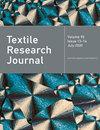利用一体化螺旋对称流厌氧生物反应器生物脱胶苎麻纤维
IF 1.9
4区 工程技术
Q2 MATERIALS SCIENCE, TEXTILES
引用次数: 0
摘要
生物脱胶法将研究兴趣集中在纺织行业的绿色脱胶技术上,既解决了化学脱胶法造成的环境污染、用水和能源消耗问题,又提高了纤维质量。纤维化学脱胶方法的最新发展应用仍然是环境保护的一项挑战。新型螺旋对称流厌氧生物反应器被应用于一个集成苎麻脱胶工艺并减少废水产生的系统中。本研究分析了液体配比对水质指标、纤维质量和微生物群落组成的影响。经过这项研究,出水的化学需氧量浓度、pH 值和氨氮分别为 264.2 ± 114.2、7.2 ± 0.1 和 7.4 ± 4.8 mg/L。这表明平均化学需氧量去除率为 55.7 ± 11.8%,比以往的生物脱胶方法高出 79%以上。纤维质量符合苎麻精干麻标准要求。高通量测序结果显示,微生物群落适应了这一过程。优势微生物(类杆菌属和甲烷属)的相对丰度能够进行生物降解和产生甲烷。这项研究为纺织业展示了一种前景广阔的绿色脱胶技术和生态友好理念。本文章由计算机程序翻译,如有差异,请以英文原文为准。
Bio-degumming of ramie fiber using an integrated spiral symmetry stream anaerobic bioreactor
The bio-degumming method focused research interest on green degumming technology in the textile sector, addressing environmental pollution, water usage and energy consumption caused by chemical degumming methods while enhancing fiber quality. The application of recent developments in the chemical degumming method of fiber remains a challenge for environmental protection. The novel spiral symmetry stream anaerobic bioreactor was employed in a system that integrates the ramie degumming process and reduces wastewater generation. This study analyzed the effect of liquor ratios on the water quality indicators, fiber quality and microbial community composition. After this study, the effluent chemical oxygen demand concentration, pH and ammonia nitrogen were 264.2 ± 114.2, 7.2 ± 0.1 and 7.4 ± 4.8 mg/L, respectively. This shows a mean chemical oxygen demand removal rate of 55.7 ± 11.8%, which is over 79% higher than previous bio-degumming methods. The fiber quality met the ramie fine dry hemp standard requirements. The high-throughput sequencing results revealed that the microbial community adapted to this process. The relative abundance of dominant microbes ( Bacteroidetes and Methanosaeta), which perform biodegradation and methane production, was present. This study demonstrates a promising green degumming technology and eco-friendly concept for the textile industry.
求助全文
通过发布文献求助,成功后即可免费获取论文全文。
去求助
来源期刊

Textile Research Journal
工程技术-材料科学:纺织
CiteScore
4.00
自引率
21.70%
发文量
309
审稿时长
1.5 months
期刊介绍:
The Textile Research Journal is the leading peer reviewed Journal for textile research. It is devoted to the dissemination of fundamental, theoretical and applied scientific knowledge in materials, chemistry, manufacture and system sciences related to fibers, fibrous assemblies and textiles. The Journal serves authors and subscribers worldwide, and it is selective in accepting contributions on the basis of merit, novelty and originality.
 求助内容:
求助内容: 应助结果提醒方式:
应助结果提醒方式:


